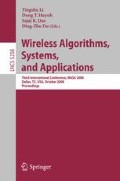Abstract
When sensors are deployed into a space instead of a plane, the mathematical model for the sensor network should be a unit ball graph instead of a unit disk graph. It has been known that the minimum connected dominating set in unit disk graph has a polynomial time approximation scheme (PTAS). Could we extend the construction of this PTAS for unit disk graphs to unit ball graphs? The answer is NO. In this paper, we will introduce a new construction, which gives not only a PTAS for the minimum connected dominating set in unit ball graph, but also improves running time of PTAS for unit disk graph.
Access this chapter
Tax calculation will be finalised at checkout
Purchases are for personal use only
Preview
Unable to display preview. Download preview PDF.
References
Alzoubi, K.M., Wan, P., Frieder, O.: Message-optimal connected dominating sets in mobile ad hoc networks. In: Proceedings of the 3rd ACM international symposium on Mobile ad hoc networking and computing, Lausanne, Switzerland, June 09-11 (2002)
Bharghavan, V., Das, B.: Routing in ad hoc networks using minimum connected dominating sets. In: International Conference on Communication, Montreal, Canada (June 1997)
Blum, J., Ding, M., Cheng, X.: Applications of Connectd Dominating Sets in Wireless Netwoks. In: Du, D.-Z., Pardalos, P. (eds.) Handbook of combinatorial Optimization, pp. 329–369. Kluwer Academic Publisher, Dordrecht (2004)
Butenko, S., Ursulenko, O.: On minimum connected dominating set problem in unit-ball graphs (submitted)
Cadei, M., Cheng, M.X., Cheng, X., Du, D.: Connected domination in ad hoc wireless networks. In: Proc. the Sixth International symposium on Mobile ad hoc networking and computing, Lausanne, Switzerland, June 09-11 (2002)
Cheng, X., Huang, X., Li, D., Wu, W., Du, D.: A polynomial-time approximation scheme for minimum connected dominating set in ad hoc wireless networks. Networks 42, 202–208 (2003)
Clark, B.N., Colbourn, C.J., Johnson, D.S.: Unit disk graphs. Discrete Math. 86, 165–177 (1990)
Guha, S., Khuller, S.: Approximation algorithms for connected dominating sets. Algorithmica 20, 374–387 (1998)
Hochbaum, D.S., Maass, W.: Approximation schemes for covering and packing problems in image processing and VLSI. J. ACM 32, 130–136 (1985)
Min, M., Du, H., Jia, X., Huang, C.X., Huang, S.C., Wu, W.: Improving construction for connected dominating set with Steiner tree in wireless sensor networks. J. Global Optimization 35, 111–119 (2006)
Peter Chen, Y., Liestman, A.L.: Approximating minimum size weakly-connected dominating sets for clustering mobile ad hoc networks. In: Proceedings of the third ACM international symposium on Mobile ad hoc networking and computing, Lausanne, Switzerland, June 09-11 (2002)
Ramamurthy, B., Iness, J., Mukherjee, B.: Minimizing the number of optical amplifiers needed to support a multi-wavelength optical LAN/MAN. In: Proc. IEEE INFOCOM 1997, April 1997, pp. 261–268 (1997)
Ruan, L., Du, H., Jia, X., Wu, W., Li, Y., Ko, K.: A greedy approximation for minimum connected dominating set. Theoretical Computer Science 329, 325–330 (2004)
Salhieh, A., Weinmann, J., Kochha, M., Schwiebert, L.: Power Efficient topologies for wireless sensor networks. In: ICPP 2001, pp. 156–163 (2001)
Sivakumar, R., Das, B., Bharghavan, V.: An improved spine-based infrastructure for routing in ad hoc networks. In: IEEE Symposium on Computer and Communications, Athens, Greece (June 1998)
Stojmenovic, I., Seddigh, M., Zunic, J.: Dominating sets and neighbor elimination based broadcasting algorithms in wireless networks. In: Proc. IEEE Hawaii Int. Conf. on System Sciences (January 2001)
Wan, P., Alzoubi, K.M., Frieder, O.: Distributed construction of connected dominating set in wireless ad hoc networks. In: Proc. Infocom 2002 (2002)
Wu, J., Li, H.L.: On calculating connected dominating set for efficient routing in ad hoc wireless networks. In: Proceedings of the 3rd ACM International Workshop on Discrete Algorithms and Methods for Mobile Computing and Communications, pp. 7–14 (1999)
Zong, C.: Shere pachings. Springer, New York (1999)
Author information
Authors and Affiliations
Editor information
Editors and Affiliations
Rights and permissions
Copyright information
© 2008 Springer-Verlag Berlin Heidelberg
About this paper
Cite this paper
Zhang, Z., Gao, X., Wu, W., Du, DZ. (2008). PTAS for Minimum Connected Dominating Set in Unit Ball Graph. In: Li, Y., Huynh, D.T., Das, S.K., Du, DZ. (eds) Wireless Algorithms, Systems, and Applications. WASA 2008. Lecture Notes in Computer Science, vol 5258. Springer, Berlin, Heidelberg. https://doi.org/10.1007/978-3-540-88582-5_17
Download citation
DOI: https://doi.org/10.1007/978-3-540-88582-5_17
Publisher Name: Springer, Berlin, Heidelberg
Print ISBN: 978-3-540-88581-8
Online ISBN: 978-3-540-88582-5
eBook Packages: Computer ScienceComputer Science (R0)

